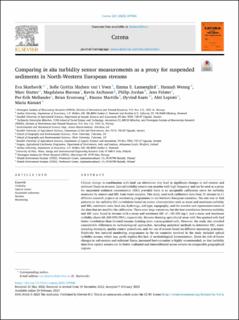| dc.contributor.author | Skarbøvik, Eva | |
| dc.contributor.author | Gyritia Madsen van't Veen, Sofie | |
| dc.contributor.author | Lannergård, Emma E. | |
| dc.contributor.author | Wenng, Hannah Tabea | |
| dc.contributor.author | Stutter, Marc | |
| dc.contributor.author | Bieroza, Magdalena | |
| dc.contributor.author | Atcheson, Kevin | |
| dc.contributor.author | Jordan, Philip | |
| dc.contributor.author | Fölster, Jens | |
| dc.contributor.author | Mellander, Per-Erik | |
| dc.contributor.author | Kronvang, Brian | |
| dc.contributor.author | Marttila, Hannu | |
| dc.contributor.author | Kaste, Øyvind | |
| dc.contributor.author | Lepistö, Ahti | |
| dc.contributor.author | Kämäri, Maria | |
| dc.date.accessioned | 2023-10-04T08:28:36Z | |
| dc.date.available | 2023-10-04T08:28:36Z | |
| dc.date.created | 2023-03-18T04:45:23Z | |
| dc.date.issued | 2023-02-24 | |
| dc.identifier.citation | Skarbøvik, E., Gyritia Madsen van’t Veen, S., Lannergård, E. E., Wenng, H., Stutter, M., Bieroza, M., Atcheson, K., Jordan, P., Fölster, J., Mellander, P.-E., Kronvang, B., Marttila, H., Kaste, Ø., Lepistö, A., & Kämäri, M. (2023). Comparing in situ turbidity sensor measurements as a proxy for suspended sediments in North-Western European streams. CATENA, 225, 107006. | en_US |
| dc.identifier.issn | 0341-8162 | |
| dc.identifier.uri | https://hdl.handle.net/11250/3094037 | |
| dc.description.abstract | Climate change in combination with land use alterations may lead to significant changes in soil erosion and sediment fluxes in streams. Optical turbidity sensors can monitor with high frequency and can be used as a proxy for suspended sediment concentration (SSC) provided there is an acceptable calibration curve for turbidity measured by sensors and SSC from water samples. This study used such calibration data from 31 streams in 11 different research projects or monitoring programmes in six Northern European countries. The aim was to find patterns in the turbidity-SSC correlations based on stream characteristics such as mean and maximum turbidity and SSC, catchment area, land use, hydrology, soil type, topography, and the number and representativeness of the data that are used for the calibration. There were large variations, but the best correlations between turbidity and SSC were found in streams with a mean and maximum SSC of >30–200 mg/l, and a mean and maximum turbidity above 60–200 NTU/FNU, respectively. Streams draining agricultural areas with fine-grained soils had better correlations than forested streams draining more coarse-grained soils. However, the study also revealed considerable differences in methodological approaches, including analytical methods to determine SSC, water sampling strategies, quality control procedures, and the use of sensors based on different measuring principles. Relatively few national monitoring programmes in the six countries involved in the study included optical turbidity sensors, which may partly explain this lack of methodological harmonisation. Given the risk of future changes in soil erosion and sediment fluxes, increased harmonisation is highly recommended, so that turbidity data from optical sensors can be better evaluated and intercalibrated across streams in comparable geographical regions. | en_US |
| dc.language.iso | eng | en_US |
| dc.publisher | Elsevier B.V. | en_US |
| dc.rights | Navngivelse 4.0 Internasjonal | * |
| dc.rights.uri | http://creativecommons.org/licenses/by/4.0/deed.no | * |
| dc.title | Comparing in situ turbidity sensor measurements as a proxy for suspended sediments in North-Western European streams | en_US |
| dc.title.alternative | Comparing in situ turbidity sensor measurements as a proxy for suspended sediments in North-Western European streams | en_US |
| dc.type | Peer reviewed | en_US |
| dc.type | Journal article | en_US |
| dc.description.version | publishedVersion | en_US |
| dc.rights.holder | © 2023 The Author(s) | en_US |
| dc.source.volume | 225 | en_US |
| dc.source.journal | CATENA | en_US |
| dc.identifier.doi | 10.1016/j.catena.2023.107006 | |
| dc.identifier.cristin | 2134986 | |
| dc.relation.project | Nordforsk: 82263 | en_US |
| dc.relation.project | Norges forskningsråd: 342631 | en_US |
| dc.relation.project | Norges forskningsråd: 243967 | en_US |
| dc.source.articlenumber | 107006 | en_US |
| cristin.ispublished | true | |
| cristin.fulltext | original | |
| cristin.qualitycode | 1 | |

